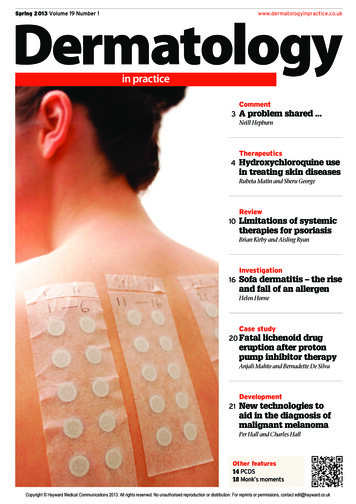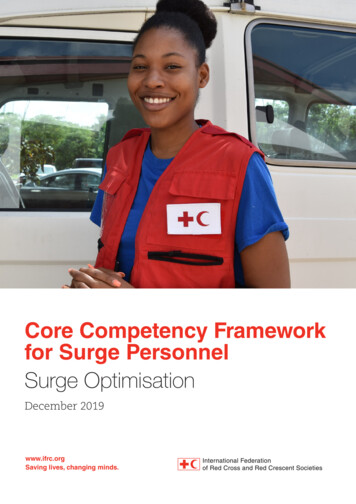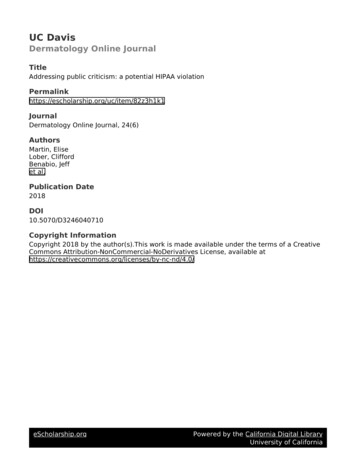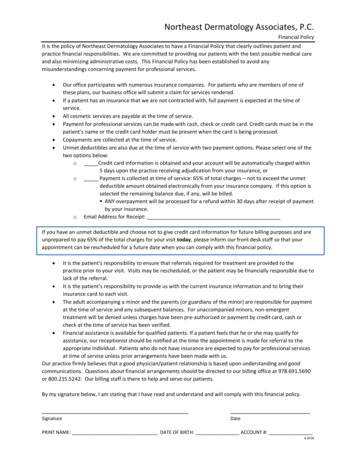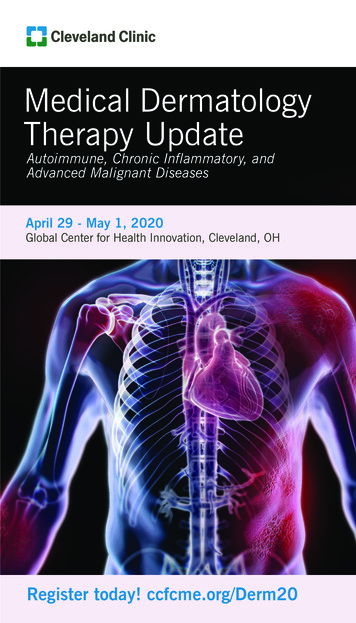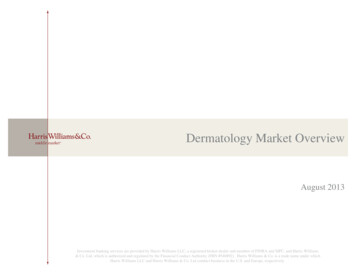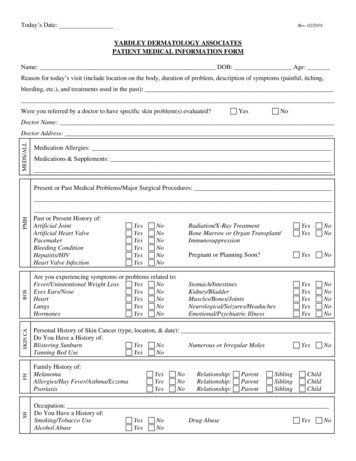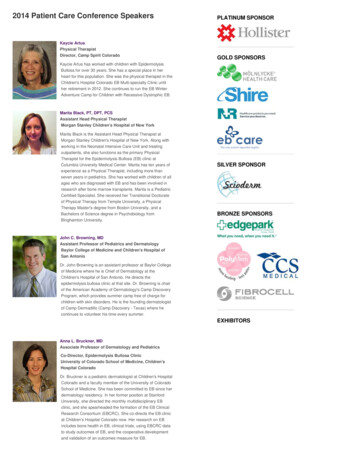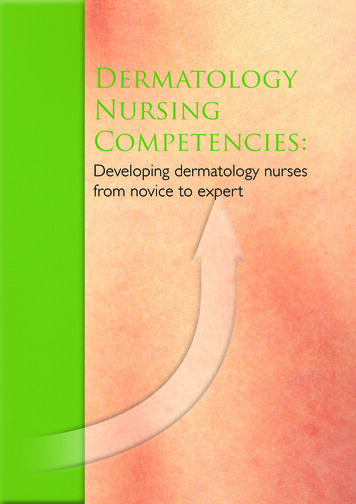
Transcription
DermatologyNursingCompetencies:Developing dermatology nursesfrom novice to expert
Dermatology Nursing COMPETENCIESDermatology Nursing Competencies is produced by the British Dermatological Nursing Group.Working Group/AuthorsAnn Davies — Clinical Nurse Specialist in Dermatology, Welsh Institute of Dermatology, University Hospitalof Wales, CardiffDiane Joseph — Dermatology Clinical Nurse Specialist, Hywel Dda Health Board, WalesBarbara Page — Dermatology Liaison Nurse Specialist, Queen Margaret Hospital, Dunfermline, FifeLiz Parrish — Lead Nurse/Matron, Friends Dermatology Department, East Kent Hospitals UniversityFoundation TrustAnne Marie Price — Clinical Nurse Specialist Dermatology, Sussex Community NHS TrustSaskia Reeken — Clinical Nurse Specialist Skin Cancer & Dermatology, Kingston Hospital, SurreySheila Robertson — Dermatology Liaison Nurse Specialist, Victoria Hospital Kirkcaldy, FifeThis document was reviewed by Professor S Ersser, Professor of Nursing & Dermatology Care, & Dean,Faculty of Health & Social Care, University of Hull.This guide is produced by the BDNG, 88 Kingsway, London WC2B 6AA. Tel: 020 7681 613.www.bdng.org.ukAll rights reserved. No part of this publication may be reproduced, stored or transmitted in any form or byany means without the prior written permission of the BDNG. Opinions expressed in articles are those ofthe authors and do not necessarily reflect those of the BDNG or the editorial/advisory board.2BDNG, July 2012, www.bdng.org.uk
Dermatology Nursing COMPETENCIESDermatology Nursing CompetenciesCONTENTSIntroduction, assessing competence, how to use this framework4Domain 1: Underpinning knowledgeCompetence: Demonstrate knowledge of the anatomy and physiology of normal skin and its appendages 5Domain 2: Dermatological assessment and investigationCompetence: Demonstrate knowledge of the assessment required in caring for patients withdermatological conditionsCompetence: Demonstrate knowledge of the investigations required in caring for patients withdermatological conditions67Domain 3: Therapeutic interventionsCompetence: Demonstrate knowledge of topical medications used to effectively treat commondermatological conditionsCompetence: Demonstrate knowledge of systemic treatments used to treat dermatological conditionsDomain 4: Caring for the patient with a dermatological conditionCompetence: Demonstrate knowledge on recognising signs of skin deteriorationCompetence: Demonstrate knowledge on developing a professional relationship with patientsCompetence: Demonstrate knowledge on care of the acutely ill/compromised patient with adermatological condition89111213Domain 5: Psychological impact of living with skin diseaseCompetence: Demonstrate knowledge of psychosocial issues which impact on the patient living withskin disease14Domain 6: Patient educationCompetence: Demonstrate knowledge of patient self-management strategiesCompetence: Demonstrate knowledge of health promotion strategiesCompetence: Demonstrate knowledge on improving treatment adherence151616Glossary of DescriptorsDirect Observation of Procedural Skills (DOPS) GuidanceCase based Discussion (CbD) GuidanceMini Clinical Evaluation Exercise (Mini-CEX) Guidance18202021BDNG, July 2012, www.bdng.org.uk3
Dermatology Nursing COMPETENCIESDermatology NursingCompetenciesIntroductionDermatological conditions affect asignificant number of the generalpopulation. Survey evidence suggeststhat around 54% of the UK populationexperience a skin condition in a given12-month period (Schofield et al, 2009).While many of these people self-managetheir conditions, around 14% seek furtheradvice from their doctor or nurse inthe community (Schofield et al, 2009).Many of those will suffer from chronicskin conditions such as psoriasis andeczema, where long-term treatment andmanagement is required.There is an emphasis with changinghealthcare policies in the United Kingdomto care for patients closer to home, makingcare more accessible.The current NationalHealth Service (NHS) White Paper(Department of Health, 2010) makes avaluable statement when it recognisesthat healthcare professionals who areempowered, engaged and supportedprovide better patient care. With continualevolving changes to healthcare policies andthe introduction of Agenda for Change, itis important to have a career frameworkfor nurses that is competency-based to aidand support this statement.A nurse is deemed competent whenhe/she possesses the knowledge, skills andabilities required for lawful, safe and effectiveprofessional practice.This frameworkfocuses on the core competencies forevery registered nurse working in thespeciality of dermatology, irrespective of thesetting.This framework is neither exhaustivenor highly specific and is intended tostimulate further discussion at local level.The objectives for competentdermatology nurses will include:8 Providing evidence-based, high-quality,appropriate care in collaboration withpatient/carer4BDNG, July 2012, www.bdng.org.uk8 Empowering all to make informedchoices8 Recognising and alleviating psychosocialimpact of skin disease8 Promoting self-management andindependence.The British Dermatological NursingGroup convened a working partyof experienced dermatology nursesto develop this competency-basedframework, which can be used as anadjunct with the Agenda for ChangeKnowledge and Skills Framework.Thiscompetency framework looks at thecompetencies required to developdermatology nurses from novice toexpert, focusing on the nurse’s educationaldevelopment in combination withknowledge and skills.Assessing competencein some circumstances, assessingcompetence can take place in manyforms, eg peer review, self-assessmentand reflection. Assessment tools that areused by other professional colleagues(Dermatologist, SpR, etc) are provided asseparate appendices (Joint Royal Collegesof Physicians Training Board, 2007).They are:Direct Observation of a ProceduralSkill (DOPS) — this assesses performanceto undertake a practical procedure.Case based Discussion (CbD) —this assesses performance in patientmanagement.Mini Clinical Evaluation Exercise (MiniCEX) — this assesses a clinical encounterwith a patient.Being competent does not just meanthat you are able to undertake a tasksatisfactorily according to a protocol, it alsomeans that you have the cognitive skillsof decision-making and the theoreticalknowledge that backs up what you do andwhy you do it.They can be used in clinical practiceand a full explanation of how to use themis included. Although they are adaptedfrom a medical model, these particularassessment tools were written withnursing colleagues in mind.Nurses have a legal requirement forcontinued professional developmentto safeguard the health and wellbeingof patients through Post RegistrationEducation and Practice (PREP) (Nursingand Midwifery Council, 2010). Nursesare committed to maintaining a personaldevelopment portfolio under PREP toensure high standards of practice andcare. A portfolio is a collection of evidenceto demonstrate skills, knowledgeand achievements that reflect thecurrent development and activity of theindividual nurse.The framework covers the following sixdomains:8 Underpinning knowledge8 Dermatological assessment andinvestigations8 Therapeutic interventions8 Caring for the patient with adermatological condition8 Psychological impact of living with adermatological condition8 Patient education.This framework outlines evidence forlearning and development. While directobservation assessment is importantLevel 1This level defines the entry point forregistered nurses to the speciality ofHow to use this frameworkCompetencies are set out within each of thesedomains and are divided into three levels:
Dermatology Nursing COMPETENCIESLevel 2This level defines the competent nurseand establishes the minimum level ofknowledge and skills required for allnurses working within dermatology.Level 3This level defines the Specialist Nurse andreflects the extension and expansion ofthe nurse’s role. There is a clear distinctionbetween this role as a Specialist Nurseand a nurse simply working within thespeciality. Dermatology Specialist Nursestypically undertake a diverse rangeof roles, including nurse-led services.Dermatology Specialist Nurses practicingat this level are able to work accordingto local and national evidence-basedprotocols and can work autonomously toco-ordinate and deliver comprehensivecare of patients.Domain 1Underpinning knowledgeCompetence: Demonstrate knowledge of the anatomy and physiology of normal skinand its appendages.CompetenceLevel 1dermatology. Nurses new to dermatologymay be limited to supporting seniornursing colleagues and doctorsthroughout individual episodes of patientcare.Explain mechanism ofskin cell turnover.Level 2Demonstrateknowledge andunderstandingof anatomy andphysiology ofnormal skin andits appendages.Evidence of learning/developmentEach competence contains this list assources of evidence to demonstratelearning or identify areas for development.The list is further expanded in theGlossary of Descriptors.Nursing and Midwifery Council (2010) ThePREP Handbook. Nursing and MidwiferyCouncil, LondonSchofield JK, Grindlay D, Williams HC(2009) Skin Conditions in the UK: AHealth Care Needs Assessment. Centre ofEvidence Based Dermatology, University ofNottingham, UKLevel 3Joint Royal Colleges of Physicians TrainingBoard (2007) Workplace Based s/Workplace-Based-Assessment.aspx (Accessed26 June, 2012)Distinguish betweennormal and abnormalfeatures of the skinstructure and itsappendages.Relate abnormalitiesin the anatomy andphysiology of the skinto the disease process.KSFC1 L2C2 L2DOPSCbDMini-CexEducationC1 L3Analysis of learningC2 L3CommunicationPersonaldevelopment plansDOPSCbDMini-CexReferencesDepartment of Health (2010) Equity andExcellence: Liberating the NHS. Departmentof Health, LondonEvidenceof learning/developmentState the layers andEducationappendages of the skin.Analysis of learningState the structuresCommunicationcontained within theepidermis, dermis and Personaldevelopment planssubcutaneous layer.Explain how layers ofthe skin work.Standard indicatorsThis sets out the level of knowledge andunderstanding which the nurse shouldhave in relation to the three levels ofcompetence.Have anawareness ofanatomy andphysiology ofnormal skin andits appendages.Standard indicatorsHave acomprehensiveknowledge andunderstandingof normalskin and itsappendages,the conceptof skin barrierand theirsignificance inskin disorders.Demonstrate criticalanalysis of anatomyand physiology ofskin applied to skindisorders.EducationC1 L4Analysis of learningC2 L4CommunicationG1 L3Educate otherhealthcareprofessionals, patientsand carers.Mini-CexPersonaldevelopment plansUnderstanding of theimmunology of theDOPSskin and its relationshipCbDto skin diseases.Relate anatomy andphysiology of the skinthat supports skinbarrier function.BDNG, July 2012, www.bdng.org.uk5
Dermatology Nursing COMPETENCIESDomain 2Dermatological assessment and investigationCompetence: Demonstrate knowledge of the assessment required in caring for patients with dermatological conditions.CompetenceEvidence of learning/developmentKSFHave an awareness of holistic patientassessment.Awareness of dermatological assessmenttools available to monitor skin diseases.Maintain privacy and dignity of patients.Awareness of common skin diseases.Description of common diseases.Awareness of psychological impact of skindiseases.Awareness of documentation.Awareness of local and national guidelines.Aware of equality and diversity.Aware of health promotion.Patient careCommunicationEducationPersonal developmentplanHealth educationAnalysis of learningDevelop learningcontracts necessary forspecialtyDOPSCbDMini-CexC1 L2C3 L2HWB6 L2HWB7 L2Demonstrate knowledgeand understanding of theassessment of a patient witha dermatological condition.Undertake holistic patient assessment.Demonstrate knowledge of the various skindiseases.Demonstrate knowledge of the assessmenttools available for measuring skin conditions.Have knowledge of local and nationalguidelines.Maintain patient privacy and dignity.Communicate with other disciplines at anappropriate level.Evaluation of patient assessment.Aware of equality and diversity.Have knowledge of health promotion.Plan care.Patient careCommunicationEducationPersonal developmentplanMedicine managementHealth educationAnalysis of learningResearch developmentPresentation skillsDOPSCbDMini-CexC1 L3C3 L3HWB6 L3HWB7 L3Have a comprehensiveknowledge andunderstanding of theassessment of a patient witha dermatological condition.Competent in taking a patient history.Take action of appropriate findings.Ensure privacy and dignity.Evaluation of care.Mentor colleagues.Diagnostic assessment.Autonomously plan patient care.Educational support of patients.Support and educate other members of themultidisciplinary team.Contribute to local and national guidelines.Identify patients with complex health issues.Refer effectively to other disciplines.Actively promote equality and diversity.Actively involved in health promotion.Patient careCommunicationEducationPresentation skillsMedicine managementHealth educationPersonal developmentplanResearch developmentAnalysis of learningPresentation skillsDOPSCbDMini-CexC1C3HWB6 L3-4HWB7 L3-4G1 L2-3Level 1Have an awareness of howto assess a patient withdermatological conditions.Level 2Level 36Standard indicatorsBDNG, July 2012, www.bdng.org.uk
Dermatology Nursing COMPETENCIESDomain 2 cont.Dermatological assessment and investigationLevel 3Level 2Level 1Competence: Demonstrate knowledge of the investigations required in caring for patients with dermatological conditions.Evidence of learning/developmentCompetenceStandard indicatorsKSFHave an awareness ofcommon dermatologicalinvestigations for diagnosticpurposes such as:Bloods for haematology andbiochemistry;Swabs for microbiology andvirology;Skin tissue for pathology;Samples for mycology,eg, skin scrapings and nailclippings.Describe and understand investigations.Aware of their findings and action required.Aware of appropriate treatment required.Aware of adverse reaction of theseinvestigations.Able to understand the procedures involvedin obtaining specimens.Patient careAnalysis of learningEducationPersonal developmentplanCommunicationDevelop learningcontracts necessary forspecialtyDOPSCbDMini-CexC1 L2C3 L2HWB2 L2HWB7 L2Demonstrate knowledgeand understanding of thecommon dermatologicalinvestigation for diagnosticpurposes and subsequenttreatment.Advise patient/carer on investigations andtreatment and what is involved in obtainingspecimens.Able to liaise with other healthcareprofessionals.Able to deal and advise appropriately withresults of investigations and subsequenttreatment.Minimise adverse affects.Able to correctly obtain specimens.Provide patients with appropriateinformation.Refer to other disciplines.Patient careEducationAnalysis of learningPersonal developmentplanResearch developmentCommunicationMedicine managementPresentation skillsDOPSCbDMini-CexC1 L3C3 L3HWB2 L3HWB7 L3Have a comprehensiveknowledge andunderstanding ofdermatological investigations,able to interpret the resultsand initiate subsequenttreatment.Able to autonomously request andundertake dermatological investigations.Able to interpret and action results.Able to advise patient/carer.Able to communicate with other healthprofessionals.Able to educate and support other healthprofessionals.Minimise adverse affects.Refer to other disciplines.Autonomously develop treatment plans onthe basis of investigations.Patient careCommunicationAnalysis of learningEducationPresentation skillsProfessionaldevelopment planMedicine managementResearch developmentDOPSCbDMini-CexC1 L3-4C3 L3-4C5 L2-3HWB2 L3-4HWB7 L3-4G1 L2-3BDNG, July 2012, www.bdng.org.uk7
Dermatology Nursing COMPETENCIESDomain 3Therapeutic interventionsCompetence: Demonstrate knowledge of topical medications used to effectively treat common dermatological conditions.KSFDescribe common dermatologicalconditions.Demonstrate awareness of topical therapies.Awareness of risks and benefits of topicaltherapies.Able to safely apply topical medications,according to prescription or patient groupdirectives.Educate patients/carers.Discuss expectations/potential outcomes.Promote self-care where possible.Patient careAnalysis of learningPersonal developmentplansLearning contractEducationMedicine managementCommunicationPresentation skillsDOPSCbDMini-CexC1 L2,C2 L2HWB1 L2HWB5 L2Level 1Evidence of learning/developmentHave an awareness of thenursing assessment, corenursing care and topicalmedications required forpatients with: Eczema Psoriasis Bullous skin disorders Severe drug eruptions Erythrodermic conditions Acute skin infections andinfestations Cutaneous cancers andpre-cancerous lesions Acne and rosacea Leg ulcers Scalp conditionsDemonstrate knowledgeand understanding of thenursing assessment, corenursing care and topicalmedications required forpatients with: Eczema Psoriasis Bullous skin disorders Severe drug eruptions Erythrodermic conditions Acute skin infections andinfestations Cutaneous cancers andpre-cancerous lesions Acne and rosacea Leg ulcers Scalp conditionsDemonstrate awareness of differenttreatment options.Discuss different treatment optionscomprehensively with patient/carers.Discuss risks/benefits of treatments.Discuss strategies for topical management.Discuss expectations/potential outcomes.Demonstrate awareness of treatmentadherence issues and how to prevent/manage them.Patient careAnalysis of learningPersonal developmentplansLearning contractEducationMedicine managementPresentation skillsCommunicationResearch developmentDOPSCbDMini-CexC1 L3C2 L3HWB1 L3HWB5 L3Have a comprehensiveknowledge andunderstanding of the nursingassessment, core nursingcare and topical medicationsrequired for patients with: EczemaUndertake patient consultation, assessmentand/or review.Discuss expectations/potential outcomes.Make prescribing and or medicinesmanagement decisions in partnership withthe patient after discussion/explanation of alloptions.Formulate treatment plan.Patient careAnalysis of learningPersonal developmentplansEducationMedicine managementPresentation skillsCommunicationC1 L3-4C2 L3-4HWB1 L3-4HWB5 L3-4G1 L2-3Level 38Standard indicatorsLevel 2CompetenceBDNG, July 2012, www.bdng.org.uk
Dermatology Nursing COMPETENCIESDomain 3 cont.Therapeutic interventionsLevel 3Competence Psoriasis Bullous skin disorders Severe drug eruptions Erythrodermic conditions Acute skin infections andinfestations Cutaneous cancers andpre-cancerous lesions Acne and rosacea Leg ulcers Scalp conditionsStandard IndicatorsEvidence of learning/developmentManage risks (adverse effects) of treatment.Able to teach other health professionals.Independent non-medical prescriber.Patient education to support effectivetopical therapy.Research : Demonstrate knowledge of systemic treatments used to treat dermatological conditions.Level 2Level 1CompetenceStandard indicatorsEvidence of learning/developmentKSFHave an awareness of thenursing assessment, corenursing care and systemicmedications that may berequired for patients with: Eczema Psoriasis Bullous skin disorders Severe drug eruptions Erythrodermic conditions Acute skin infections andinfestations Acne and rosacea Scalp conditionsDescribe common dermatologicalconditions.Demonstrate awareness of systemictherapies.Awareness of risks and benefits of systemictherapies.Educate the patient/carers.Discuss expectations/potential outcomes.Promote self-care where possible.Patient careAnalysis of learningPersonal developmentplansLearning ContractEducationMedicine managementCommunicationDOPSCbDMini-CexC1 L2C2 L2HWB1 L2HWB7 L2Demonstrate knowledgeand understanding of thenursing assessment, corenursing care and systemicmedications that may berequired for patients with: Eczema Psoriasis Bullous skin disorders Severe drug eruptions Erythrodermic conditionsDemonstrate awareness of differenttreatment options and the concept of firstand second line treatments.Discuss different treatment optionscomprehensively with patient /carers.Discuss risks/benefits of treatments.Discuss strategies for management.Discuss expectations/potential outcomes.Recognise adverse effects and be able totake appropriate action.Patient careAnalysis of learningPersonal developmentplansEducationMedicine managementPresentation skillsCommunicationResearch developmentDOPSCbDMini-CexC1 L3C2 L3HWB1 L3HWB7 L3BDNG, July 2012, www.bdng.org.uk9
Dermatology Nursing COMPETENCIESDomain 3 cont.Therapeutic interventionsLevel 3Level 2Competence10Standard indicatorsEvidence of learning/developmentKSF Acute skin infections andinfestations Acne and rosacea Scalp conditionsHave a comprehensiveknowledge andunderstanding of thenursing assessment, corenursing care and systemicmedications that may berequired for patients with: Eczema Psoriasis Bullous skin disorders Severe drug eruptions Erythrodermic conditions Acute skin infections andinfestations Acne and rosacea Scalp conditionsUndertake patient consultation, assessmentand/or review.Medication contraindications andinteractions associated with treatments.Discuss expectations/potential outcomes.Make prescribing decisions in partnershipwith the patient after discussion/explanationof all options available.Formulate treatment plan.Able to teach other healthcare professionals.Review and monitor systemic therapy.Ability to refer to other appropriate healthprofessionals in case of treatment failure oradverse effects.Able to educate patients regarding thepotential risks of systemic therapy.Independent non-medical prescriber.BDNG, July 2012, www.bdng.org.ukPatient careAnalysis of learningPersonal developmentplansEducationMedicine managementPresentation skillsCommunicationResearch developmentPublicationDOPSCbDMini-CexC1 L2C2 L2HWB1 L3-4HWB7 L3-4G1 L2-3
Dermatology Nursing COMPETENCIESDomain 4Caring for the patient with a dermatological conditionCompetence: Demonstrate knowledge on recognising signs of skin deterioration.Level 3Standard indicatorsEvidence of learning/developmentKSFRecognise and describe signs Monitor symptoms and recommendand symptoms of commontreatment changes in consultation withdermatological conditions.patient.Identify dermatological conditions andtreatments where an infection is a particularproblem.Minimise the risk of spread of infection toothers.Apply dermatology terminology whenidentifying and documenting skin assessment.Identify the common distribution sites oflesions/rashes.Patient careCommunicationAnalysis of learningDOPSCbDMini-CexC1 L2C2 L2HWB5 L2HWB6 L2Awareness of investigationand treatment regimens formanagement of commondermatological conditions.Awareness of common side-effects.Provision of information for patient onpotential variations in pattern, severity andduration of symptoms.Describe the major adult/childhoodassociated conditions.Collect and collate evidence to documentremission.Demonstrate ability to obtain specimens.Reflect on analysis of laboratory results.Identify criteria that would determine choiceof therapeutic intervention.Demonstrate theoretical and practicalknowledge of the use of topical preparations.Patient careCommunicationAnalysis of learningDOPSCbDMini-CexC1 L3C2 L3HWB5 L3HWB6 L3Have understanding ofand ability to implementlocal/national policies andguidelines for interveningduring an acute episodeof care.Medication, contraindications andinteractions associated with treatments.Explain skin pathology to patients, carers andother healthcare professionals.Link signs and symptoms and treatmentoptions using evidence-based protocols.Describe conditions associated with theimmune system.Awareness of genetic predispositions to skinconditions.Reflect and review process of eliminationand co-morbidities.Explain steps when medication fails tocontrol the condition.Patient careCommunicationAnalysis of learningMedicinesmanagementDOPSCbDMini-CexC1 L3-4C2 L3-4HWB5 L3-4HWB6 L3-4G1 L2-3Level 2Level 1CompetenceBDNG, July 2012, www.bdng.org.uk11
Dermatology Nursing COMPETENCIESDomain 4 cont.Caring for the patient with a dermatological conditionCompetence: Demonstrate knowledge on developing a professional relationship with patients.CompetenceEvidence of learning/developmentKSFConsider holistic perspective.Aware of emotional needs.Evaluate psychosocial impact.Assess cognitive impairment.Assess sensory impairment.Understand impact of learning disability.Recognise customs and beliefs.Patient careAnalysis of learningHealth promotion/educationEducationLearning contractPersonal developmentCommunicationDOPSCbDMini-CexC1 L2C2 L2HWB5 L2HWB6 L2Demonstrate knowledgeand understanding ofefficient and effectivequestioning and clarificationtechnique with patients andcarers.Identify tensions and constraints.Involve the patient in the decision process.Assess potential problems.Identify and isolate the key issues.Clarify if understanding reached.Involve interpreting services as required.Communicate at a level appropriate to theindividual.Patient careAnalysis of learningHealth promotion/educationEducationSpecialty learningcontractPersonal developmentplanCommunicationPresentation skillsResearch developmentDOPSCbDMini-CexC1 L3C2 L3HWB5 L3HWB6 L3Have a comprehensiveunderstanding of collectingand collating evidenceto support patients andcarers and demonstrateskill in forming therapeuticrelationships.Design, develop and implement carepathways in conjunction with patient.Empower individuals.Use validated assessment tools to gradeseverity of conditions/ psychosocial impact.Exercise professional judgement and usecritical appraisal when making an assessment.Critically analyse levels of knowledge.Distinguish between subjective and objectiveinformation.Ability to recognise and demonstratetherapeutic opportunities (for patientsupport) through nursing interaction.Patient careAnalysis of learningHealth promotion/educationLearning contractPersonal developmentplanPresentation skillsCommunicationResearch developmentWriting/publicationDOPSCbDMini-CexC1 L3-4C2 L3-4HWB5 L3-4HWB6 L3-4G1 L2-3Level 1Have an awareness offactors influencing aprofessional relationship withpatients and carers.Level 2Level 312Standard indicatorsBDNG, July 2012, www.bdng.org.uk
Dermatology Nursing COMPETENCIESDomain 4 cont.Caring for the patient with a dermatological conditionCompetence: Demonstrate knowledge on care of the acutely ill/compromised patient with a dermatological condition.Have an awareness ofclinically safe practices whencaring for an ill patient.Act appropriately when an emergencyaction is required.Ensure the dignity and privacy of the patientand family.Ensure a safe environment is maintained atall times.Discuss nursing measures to keep patientfree from infection during an acute illness.Outline topical therapies to keep skin clean,lubricated and hydrated, maintaining aneffective skin barrier.Outline measures to ensure effectivenutritional, fluid and electrolyte balance.Communicate a caring, respectful andreassuring attitude to the patient and familyduring a cycle of care.Patient careAnalysis of learningPersonal developmentEducationCommunicationMedicine managementDOPSCbDMini-CexC1 L2C2 L2HWB5 L2HWB 6 L2Demonstrate knowledge,understanding and facilitateclinically safe practices whencaring for an ill patient.Prepare a plan of care appropriate to thedermatological condition.Differentiate between usual and unusualpresentations.Ensure that relatives and carers have thenecessary guidance to deal with prolongedcare.Demonstrate cardiovascular risk assessmentfor severe inflammatory disease.Maintain patient dignify and privacy.Patient careAnalysis of learningPersonal developmentEducationCommunicationMedicine managementWriting for publicationHealth educationDOPSCbDMini-CexC1 L3C2 L3HWB5 L3HWB 6L3Have a comprehensiveknowledge and awareness ofsafe practices.Initiate and lead clinically safepractices within the widerhealthcare team.Recognise complex and acute presentationalissues and identify immediate nursing supportneeded and necessary ongoing referral.Expert in assessing psychological impact of skincondition.Work on care pathways with professionals inanticipation of potential problems.Outline the physiological processes andconsequences that may result in acute illnesswith specific conditions.Maintain accurate and complete recordsconsistent with legislation policies andprocedures.Understand the concept of homeostasisas a principle informing effective nursingintervention in acute situations.Maintain patient dignify and privacy.Patient careAnalysis of learningPersonal developmentEducationCommunicationMedicine managementWriting for publicationHealth educationResearch developmentDOPSCbDMini-CexC1 L3-4C2 L3-4HWB5 L3-4HWB6 L3-4G1 L2-3Level 1Standard indicatorsLevel 2Level 3Evidence of learning/developmentCompetenceKSFBDNG, July 2012, www.bdng.org.uk13
Dermatology Nursing COMPETENCIESDomain 5Psychological Impact of living with skin diseaseCompetence: Demonstrate knowledge of psychosocial issues which impact on the patient living with skin disease.Level 3Level 2Level 1Competence14Standard indicatorsEvidence of learning/developmentKSFHave an awareness of thepsychosocial issues whichimpact on a person livingwith skin disease.Understand the importance of a holisticapproach to dermatology nursing care.State the domains of holistic care in thedermatology care context.Demonstrate an understanding of cognitive,emotional, social and spiritual needs ofpatients with skin disease.Patient careAnalysis of learningHealth educationCommunicationDOPSCbDMini-CexC1 L2,C2 L3HWB4 L3HWB5 L3Demonstrate knowledgeand understanding ofpsychosocial issues whichimpact on a person with skindisease/condition.Demonstrate clear assessment anddocumentation of patients’ cognitive,emotional, social and spiritual nee
Dermatology Nursing Competencies is produced by the British Dermatological Nursing Group. Working Group/Authors Ann Davies — Clinical Nurse Specialist in Dermatology, Welsh Institute of Dermatology, University Hospital of Wales, Cardiff Diane Joseph — Dermatology Clinical Nurse Specialist, Hywel Dda Health Board, Wales
